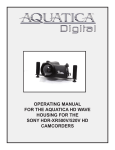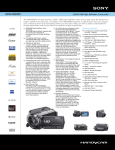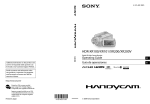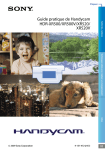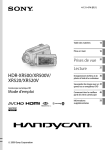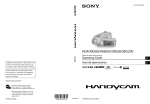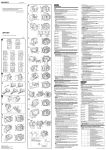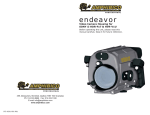Download AMPHIBICO Video Camera Housing Instruction manual
Transcript
® Visit our web site for a full list of authorized service centers and the latest dealer list Instruction Manual Video Camera Housing for SONY® HDR-XR200V/XR500V/XR520V 049-6223-001 Rev. 00 Before operating the unit, please read this manual carefully. Keep it for future reference. WARRANTY All Amphibico products are covered against defects in material or workmanship by a two year limited warranty from the date of purchase for consumer use. First year- Parts & labour; Second year- Parts only. These same products when used commercially will carry a 90-day warranty. No statutory warranty applies. Cameras and or any other end user products housed in Amphibico housings are not covered under this warranty and ANY WATER DAMAGE SUSTAINED DUE TO INSTALLATION ERROR OR FOR ANY OTHER REASON IS NOT THE RESPONSIBILITY OF AMPHIBICO INC. Therefore the appropriate insurance should be maintained by the user. Subject to the terms and conditions specified hereunder, Amphibico Inc. agrees to correct, either by repair or by replacement, any defect in material or workmanship which develops within the warranty period after delivery of the product to the original purchaser. Repair or replacement is provided in the event that investigation and factory inspection by Amphibico Inc. discloses that such a defect has developed under normal and proper use. No warranty is granted, unless otherwise specified, concerning components, accessories, or devices not manufactured by Amphibico Inc. AMPHIBICO INC. SHALL BE RELEASED FROM ALL OBLIGATIONS UNDER ITS WARRANTY IN THE EVENT REPAIRS OR MODIFICATIONS ARE MADE BY PERSONNEL OTHER THAN ITS OWN OR AUTHORIZED (IN WRITING) SERVICE PERSONNEL. Amphibico Inc., in its continued commitment to provide excellence in the field of underwater imaging, reserves the right to change specifications at any time, without notice and without incurring any obligations to incorporate new features in equipment previously sold. TABLE OF CONTENTS Features..........................................................2 Specifications..........................................................3 Housing Features and Controls.......................................................4-5 Unpacking Your Housing..........................................................6 Preparing the Camera & Housing.....................................................7-11 Opening the housing...................................................7 Setting the camera...................................................7 Installing the saddle...................................................7 Placing the camera...................................................8 Rear LCD Monitor................................................8-9 Closing the housing...................................................9 Replacing the bayonet lens.................................................10 Installing accessories.................................................10 Water Entry..................................................11 Housing Camera & Operations...................................................12-15 Power ON / OFF..................................................12 Changing MODE..................................................12 Mode settings..................................................13 Zooming..................................................14 Focusing..................................................14 One Push white balance..................................................15 Maintenance........................................................16 Servicing of O-rings........................................................17 Optional Accessories........................................................18 General Shooting Tips........................................................19 Warranty.........................................................20 CONDITIONS Registration: The attached (warranty) card must be filled out and mailed to Amphibico Inc. within fourteen (14) days after retail purchase. You can also register your product on line at the following secure web site “www.amphibico.com”. This way your product will be recorded in our data base in case it gets lost or stolen. It also allows us to contact you in the unlikely event that a safety notification is required on your product. Repairs: The unit must be returned freight prepaid to Amphibico Inc. The returned documents must show Serial N0. and be marked “ CANADIAN GOODS RETURNED.” No returns will be accepted without Amphibico Inc return authorization number. 20 1 FEATURES Our new Dive Buddy EVO HD Elite2 for the Sony HDRXR200V/XR500V/XR520V AVCHD camcorders has arrived! The much anticipated new ‘WHITE BALANCE ELECTRONIC ONE-TOUCH HAND GRIP ASSEMBLY’ is now standard for the Dive Buddy EVO HD Elite II XR200V, XR500V & XR520V Series. Now equipped with metal electronic grips and one push white balance, everyone can shoot High Definition images and take superior digital stills underwater!! Good ergonomics and electronic controls is what the Dive Buddy EVO HD offers you in a small compact housing. Electronic controls: The housing provides electronic controls on a newly designed marine grip. - Power ON / OFF - Record / Standby (Camera mode) - Shutter (Photo mode) - Zoom T & W with variable zoom speed - Mode (Camera / Photo) - Focus Lock - One Push White Balance Five Electronic Push Button Controls on Right grip : - The trigger button will access the Record / Standby function while in camera mode, and the Shutter function while in Photo mode. - Variable speed ZOOM-W & ZOOM-T engages the zoom function of the camera. - The MODE button will switch the camera from the CAMERA to the PHOTO mode. - By pressing the FOCUS mode you will engage the Focus Lock, pushing it again will bring the setting back to auto focus. - Power ON / OFF: Press on the trigger button to turn ON the unit and press again while holding down the MODE button to turn it OFF. GENERAL SHOOTING TIPS 1. Best results will be obtained with natural light if the sun is directly overhead during calm water periods. 2. Placing the sun behind your shoulder during shooting will produce the best colors. 3. Wide angle is the preferred focus setting for best results with subject, as close as possible to the housing. This will reduce the water column and the amount of particles between subject and lens. 4. In PHOTO mode, images are going to be larger than those taken in CAMERA mode. This is due to the fact that the camera uses more recordable surface of the CCD size and results in vignetting. For good digital pictures, zoom in a bit to clear lens shade edges. 5. Zooming during shooting is not recommended unless absolutely necessary as telephoto will magnify particles. Swimming toward subject is a much more visually pleasing filming method. 6. Use image stabilizer if available on your camera when filming macro to minimize camera movement during high magnification. Image stabilizer is not as critical while using wide angle and will use battery power unnecessarily. 7. Buoyancy control is one of the most important aspects of underwater videography and diving in general. Avoid disturbing bottom silt and contacting delicate reef structures. Work on controlling your breathing and your buoyancy. Your video will be much more visually appealing. You are trying to make yourself a steady shooting platform. The less movement you make , the better your video will be. Work on attaining a comfort zone underwater. The more comfortable you are underwater, the more controlled your breathing will be and the steadier your video will be. 8. In low light situations, add light with optional Amphibico video lights for brighter and more vibrant colors. As light level falls so does color saturation. Lights will also provide necessary fill during daylight shooting. If this technique is used, filtration of light using a color correction filter will be necessary for accurate color rendition. 9. All the latest HD cameras automatically white balance at start-up. You can, at start-up, point the video camera housing on your white balance slate for proper color correction. Wide angle lenses (sold separately). - Marine bayonet mounted lens system 0.55X rectilinear fully coated amphibious conversion lens, vacuum-sealed for maximum anti-fog protection. - CrystaLens95º wide angle superior lens system with a technology that allows you to capture crystal clear 100% zoom through images. Wide Angle Lens 0.55X CrystaLens95º FOV 80º 95º 2 19 OPTIONAL ACCESSORIES SPECIFICATIONS Dive Buddy EVO HD Optional Accessories (See your retailer or visit our web site for more details & pricing) - Extra large carry case Aluminium carry handle Optics - Bayonet mounted Flat Port - Bayonet mounted .55x lens - +1, +2, +4 Diopters Marine Grade Aluminium Construction Fully anodized with a hard coat of polyurethane paint All hardware is marine grade brass and stainless steel Marine bayonet mounted lens system (optics not included). Internal Flip filter with a UR Pro Blue Water Filter installed External Hydrophone* to pick up high frequency sounds, such as whales and dolphins Rear 3.5” LCD Viewfinder Accessory ports * N/A for HDR-XR200V model Weight of unit (w/o lead ballasts): Light - 10 Watt Arc Light “HID Technology” with mounting arm - Self-Contained 35/50 Watt HID Arc Light with Aluminium Arm. - On land: 11 lbs. (4.95kg) fully loaded w/camera battery and lens. - In seawater: 15-oz (425g) negative buoyancy Dimensions : Filters - UR PRO Blue Water 3”X 4” plastic Filter (fits on Flat Port & .55X lens) - UR PRO Blue Water 52mm - UR PRO Green Water 52mm - Length 12” (305mm) - Width 10.5” (267mm) - Height 6.5” (165mm) Measurements includes lens and grips Extended warranty programs available Operating depth : Each unit is pressure tested to 330ft (100m) Accessories included : - Camera Saddle Internal Filter Ring with a 52mm UR Pro Blue Water Filter O-ring kit Instruction manual LCD Monitor : - 18 Display size: 3.5” DOT format: 480 x 234 Contrast ratio: 150:1 Brightness: 200 nits Input signal: Composite, NTSC/PAL (auto switch) Operating temperature: 0° ~ 60°C 3 HOUSING FEATURES & CONTROLS SERVICING OF O-RINGS 1. O-rings and sealing surface should be lightly lubricated with silicon lubricant on a regular basis. This is not necessary after every dive; every tenth dive during regular heavy use is sufficient. This should always be done before storing the housing and before a first dive after taking the housing out of storage. 2. It is important never to use a sharp instrument when removing an o-ring as this may cause damage to the o-ring or the o-ring groove. A hairpin or a credit card works well. 3. The removed o-ring should be examined for damage. Check to make sure that the o-ring is free from nicks and cuts and that it retains its original round profile. O-rings that appear to be damaged should be discarded immediately and replaced with new o-rings. NOTE: If you have to change your O-rings, make sure you are using the o-rings provided with the package. Using different o-rings than those in the O-ring kit may cause the housing to leak and result in damage. 4. Rinse the o-ring with freshwater and dry it with a clean lint free cloth. 5. Clean the o-ring grooves (where the o-rings sit) with a Q-tip. Be sure to remove any lint the Q-tip may leave behind. Inspect the groove for damage. 6. Wipe the part of the housing that the o-ring seals against with a clean lint free cloth. 7. Re-grease the o-rings with a thin layer of silicon grease until it appears to be smooth and shiny. Do not over grease it - use just enough grease so that the o-ring will pull smoothly through your fingers. Excessive amounts will only attract dirt to the o-ring. 8. Replace o-rings in their proper position on the lens assembly and on the main door seal. 9. We recommend that you send your housing to a service centre for an overall O-ring replacement at least once a year. 1. Bayonet mounted lens (not included) 2. Incorporated T-brackets 3. Carry handle dove tail 4. Right electronic grip 5. Right grip support 6. External hydrophone (N/A for HDR-XR200V model) 7. Color correction flip filter lever 8. Accessory port (may not appear on all models) 4 17 MAINTENANCE HOUSING FEATURES & CONTROLS WARNING: DO NOT leave the housing exposed to direct sunshine, as extreme heat condition can be detrimental to certain of its components. 1. Keep housing and O-rings away from direct sunlight. Always store unit when possible away from direct sunlight as this can dry out and crack O-rings in the housing. Ultraviolet rays can damage plastics, paint and O-rings. 2. Always rinse or soak closed housing in fresh water for 10 to 15 minutes after every use. Reach into freshwater and operate all controls to clear salt water. Do not use solvents to clean unit. If preferred, use mild detergent and clean fresh water. 3. Fasteners that are removable should occasionally have the threads lubricated with silicon grease. 4. Rinse clean and remove water spots from external filters and lens surface after every dive or water spots may build up and become impossible to remove. Dry gently with a soft, lint-free cloth. 5. Inspect housing’s rear door main O-ring seals (double seals) before every dive. Make sure that there are no cracks or misalignment in the O-ring channel and that no debris is caught on the O-rings. 6. During storage or transit: 1. Remove the batteries to prevent accidental discharge. 2. Leave rear door ajar on unit to prevent damage due to extreme high pressure. 9. 3.5” Color LCD viewfinder 10. Left grip 11. Status / wet alarm LED 12. Right electronic grip 13. Right grip support 14. Safety latch 15. Accessory port 16 5 UNPACKING YOUR HOUSING Before unpacking your housing kit, inspect the shipping box as well as all contents for damage during shipping. If damage has occurred, please contact the shipping company immediately. Every Amphibico Housing is pressure tested prior to shipping. However, damage may have occurred during shipping. It is strongly recommended to test dive the housing once without camcorder installed to insure the housing is water tight. “One Push” white balance To white balance, simply press on the trigger button while holding the FOCUS button depressed. The one push white balance will execute and the manual white balance symbol ( ) will show up at the bottom left corner of the screen indicating that the camcorder’s white balance is now manually set. This instruction manual assumes that the user is already familiar with the SONY® HDR-XR200V/XR500V/XR520V camcorder. If not, please read instruction manuals thoroughly before beginning to use the housing. Your Dive Buddy EVO HD housing comes to you as follows: A) Marine Housing B) .55x lens (shown as reference only) sold separately. C) Removable / lockable camera saddle (shipped mounted into position in the housing D) Protective cover for the lens E) O-ring kit with container of silicone grease F) Instruction manual and warranty card 6 15 PREPARING CAMERA & HOUSING Zooming Opening the Housing Zoom functions have variable speeds. Pressing on the trigger button while zooming will accelerate the zoom. 1. Sit the housing on a flat surface. Press and rotate the rear door latch counter clockwise until the door is open. Zoom-W - For most users, shooting in wide Angle is a safer way to achieve good quality images. Shooting in wide angle means better control on the subject and steadier images. Zoom-T - Zooming while shooting underwater may result in bouncing images if you are not steady with the housing. Zooming in with the camera housing will give you sharp images until you reach a certain focal point past the half zooming distance. For macro shoot you must get closer to your subject and shoot wide angle. a 2. Removing the saddle: Push the saddle locking latch a inwards to release the saddle from the housing. Once released, slide the saddle out the housing b . b Setting the camera Focusing (Focus Lock) Normally focus is adjusted automatically. FOCUS button will activate or deactivate the Focus Lock function on the camera. Focus Lock can be used to fix the focus on the main subject*. This features prevents the focus from switching to other subjects such as particles or fish swimming in front of the camera housing. The indicator will appear on the screen when the Focus Lock is activated. * The Focus Lock will focus on the subject found in the middle of the viewfinder. When composing a picture, the main subject may need to be located off center. The following steps describes a method on how to achieve this. a) Position the main subject in the middle of the viewfinder. b) Press on the FOCUS button to lock the focus on the main subject. c) Move the main subject to a desired location within the viewfinder. 1. Put a fully charged battery in the camera. (Up to SONY® NP-FH100) 2. Set FLASH to “ NO FLASH” 3. Set the STD/LOW LUX/NIGHTSHOT switch to LOW LUX to get brighter images underwater. 4. In order to show the camcorder’s indicators on the LCD monitor, you must set the camcorder’s “DISP OUTPUT” to “V-OUT/PANEL”. 4 Installing the saddle 1. Attach the saddle adapter to the camcorder by inserting its mounting screw into the rear tripod receptacle of the camcorder. 2. Place the camcorder over the saddle and secured by tightening the saddle’s mounting screw onto the saddle adapter. 2 Tripod Receptacle 1 Saddle Adapter 14 3 7 PREPARING CAMERA & HOUSING 1 2 MODE SETTINGS Placing the camera into the housing 1. Connect the A/V remote cable from the rear monitor inside the housing to the A/V remote jack of the camera. 2. Engage the camera with saddle into the housing, connect the hydrophone cable* from inside the housing to the microphone jack of the camera . Loop back the cable towards you and engage the camera further into the housing. 3. Slide the camera with saddle completely inside the housing until the locking latch is engaged. 4. Turn ON the camera by pulling out its viewfinder or by opening and flipping its LCD screen. * N/A for HDR-XR200V model Camera Mode (Default) 3 Press on the trigger button to start recording. The CAM indicator light will start flashing green when recording. Pressing again on the trigger button will put the camera back on standby and the CAM indicator light will go back to a steady green. Photo Mode Use the Mode button to switch from Camera mode to Photo mode. The CAM indicator light will turn off and the PHOTO indicator light will turn on steady green. The trigger button acts as the shutter button. Rear LCD Monitor Its is recommended to place four fresh “AA” batteries into the battery holder before every dive. Operating limit: Typical alkaline batteries will produce up to 30 minutes of continuous use. Nickel metal hydride batteries (Ni-MH) will produce up to 150 minutes and non chargeable lithium batteries, on the other hand, will produce over 4 hours of continuous use! The “LOW BATT.” indicator starts to flash red once the batteries have reached their operating limit. A steady red color indicates that the batteries need to be replaced. 8 13 HOUSING CAMERA & OPERATION At this point, you should be underwater going down chasing your subject and looking for the best video shot. The Dive Buddy EVO HD housing offers a large range of functions like Zoom, record / standby, photo & camera modes and focus capabilities. This chapter will explain you how to use these functions as efficient as possible. Rear LCD Monitor (continued) Settings for the rear LCD monitor are located on the inside of the rear bulkhead and are described as follows: CONT. To adjust the contrast COLOR To adjust color saturation BRIGHT. To adjust the brightness WARNING: Power ON / OFF IT IS IMPORTANT TO REMOVE BATTERIES FROM BATTERY HOLDER AFTER EVERY USE. FAILURE TO DO SO MAY DRAIN THE BATTERIES OVER TIME AND CAUSE SEVERE DAMAGE TO THE UNIT. 1. Pressing on the trigger button will turn the unit ON. The camera will automatically turn ON and the CAM indicator will light up steady green meaning that the system is ready to operate. You can also confirm this by seeing the image appear through the rear viewfinder. Closing the housing 2. To turn the unit OFF, simply press on the trigger button while holding the MODE button depressed. The opportunity to turn OFF the unit underwater will allow you save on battery power. Changing Mode Depressing the Mode button will allow you to switch the camera to he CAMERA (default) or PHOTO mode. You will find on the next page an explanation of these two different modes. 1. While the housing is open, inspect the two O-rings and the sealing surface for dirt and debris. Refer to instructions on page 17 (Servicing of O-rings) for more information on O-rings. 2. Before inserting the camera, you should always make sure that the cable connected to the grip is never pulled out. If it is ever pulled out, make sure that the wave washer is not missing before re-connecting the cable. NOTE: The wave washer helps to keep a constant pressure on the connection. The connection may become intermittent in its absence. 3. Make sure the camera and the cables don’t block the sealing surface. If cables get pinched, the system might be intermittent or not functioning at all. Once the camera is completely in and the saddle is locked, engage the latch by turning it clockwise. 4. Make sure the o-rings are well placed before locking the latch. Turn the latch until a positive click is felt. Grip cable Wave washer 12 9 Replacing the bayonet lens Water Entry 1. To remove the lens, push and hold the button on the lower right of the front bulkhead and then turn counter clockwise until the lugs are free from the bayonet ring. Pull gently on the lens to release it. 2. Remove the rear cover from the new bayonet mounted lens and place it on the previously installed lens for safe keeping. Make sure the seals on the bottom part of the lens are clean and free from dust and debris. 3. Put a small amount of lubricant on the oring seals and the sealing surface of the housing. 4. Line up the bayonet lug marked by a hole with the printed dot on the front bulkhead of the housing. Push the lens all the way until it sits on the bayonet ring and turn clockwise. You will hear a positive click and the lens will lock into place. 1. Always make sure that the electronics of the housing is ON before entering the water. To turn it ON, use the trigger button. This is confirmed by the CAM indicator light turning on steady green. The camera viewfinder will also turn ON. Doing step 1 will activate the built-in moisture alarm sensor located in the bottom of the housing. IMPORTANT Both indicator lights will start flashing RED if water leakage occurs into the housing unit. Remove from water as soon as possible, take the camera out of the housing and inspect all seals and the inside of the housing. ALWAYS REMEMBER DIVER SAFETY FIRST. 2. Lower the housing just below the water surface in level position and hold for one minute to confirm there is no leakage in the housing. Never leap into the water while holding the housing. Always have the housing handed to you or lowered down once you are in the water. 3. Point the lens of the housing upwards and shake off any air bubbles. It may also be necessary to gently wipe the lens with your finger to remove bubbles. Installing Accessories All of the Amphibico housings are provided with brackets where optional accessories can be mounted. On the Dive Buddy EVO HD housing, these brackets have been machined directly on the body. In fact, two T-brackets are incorporated to it. A third one, which is basically done to accommodate the carry handle, is located on top of the body. Some of these accessories require communication with the camera’s electronics. Waterproof connectors need to be installed on the housing to allow information such as video or audio to travel through the electronics. Buoyancy and Balance Adding accessories to the housing may make it heavier or off balance in the water. Ballasts located on the bottom of the housing can be adjusted or removed to adjust balance and buoyancy of the housing. 10 11












